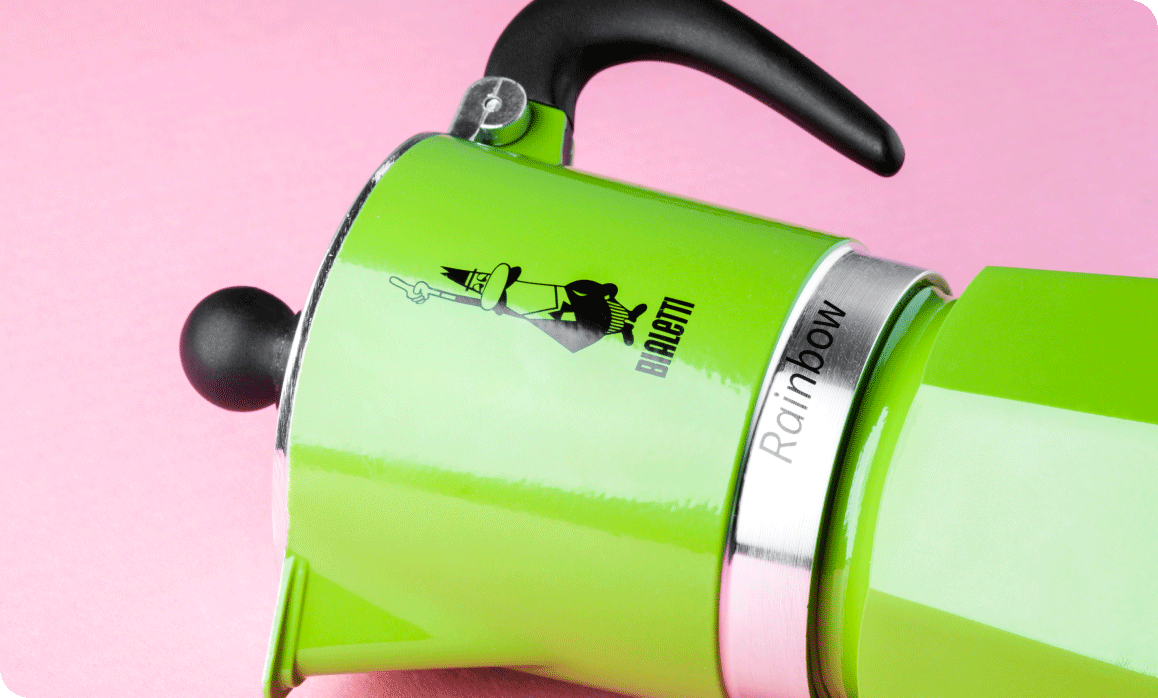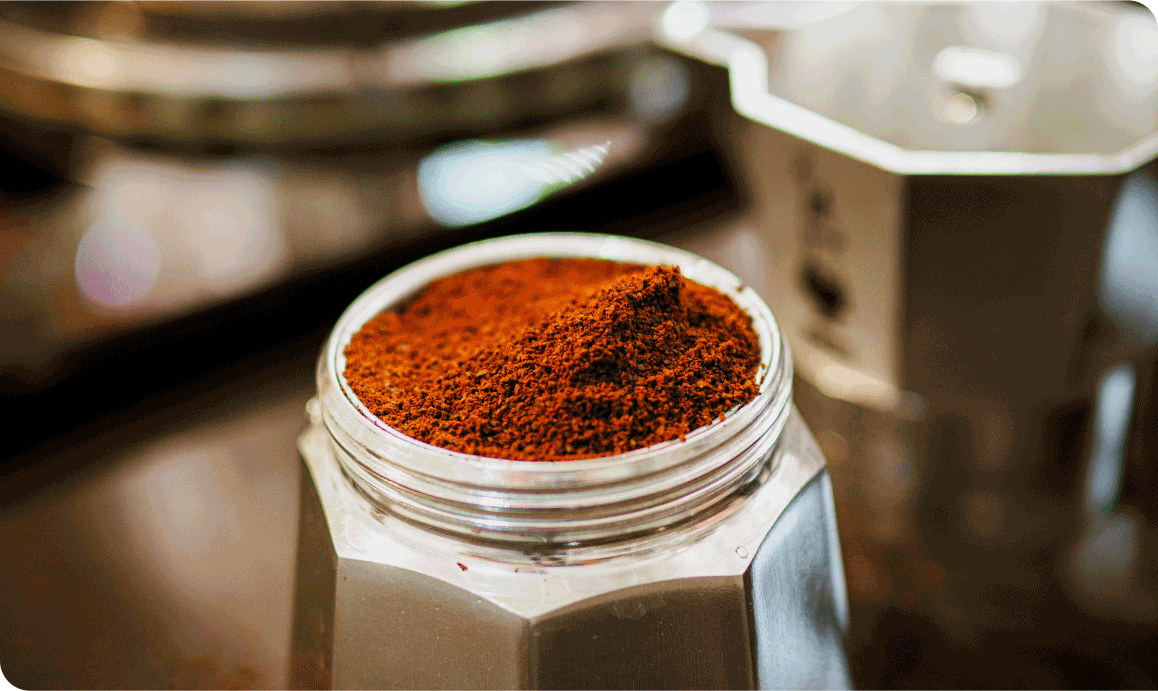A material debate: steel or aluminum coffee maker?
The steel coffee maker is an alternative to the traditional aluminum Moka pot. But are they equivalent products? Let us compare the two materials.

- When buying a new coffee maker, there are many factors to consider: from the type of use to the material.
- Is it better to opt for the traditional Moka in aluminum or steel? Both materials have strengths and weaknesses. Let us find out the main arguments.
- The aluminum Moka is cheaper and allows for faster coffee preparation. It may, however, be slightly more subject to wear and tear.
- The steel coffee maker is easy to clean and also works on induction hobs. However, it is a material that retains less of the coffee’s aroma in various applications.
Tradition and innovation
The Moka pot is the best friend of those who love a good Italian coffee. And its charm shows no sign of going out of fashion. Despite the advent of espresso machines, Moka still remains the queen of (not only) Italian kitchens today. For its practicality and manageability, no doubt, but also for its peculiar identity. Not to mention the taste: that of the coffee dispensed and also that of its preparation, a set of gestures that grow into a real ritual. The Moka Express is unique, but today there are many coffee makers, mainly created to respond to changing consumer habits. From this point of view, what is different about a steel coffee maker compared to an aluminum model? Let us find out together, comparing the two materials.

The main factors to keep in mind when buying a coffee maker
As anticipated, today there are many models of coffee makers on the market. Different not only in shape, size and color, but also in the material with which they are made. The main factors to keep in mind when buying a new coffee maker vary according to one's tastes and needs. Certainly, as we will see below, materials are an important aspect. From this point of view, usually the choice falls between an aluminum Moka pot and a steel model. A central element to consider is, undoubtedly, the area in which the coffee maker will be called upon to operate. For clarity’s sake, here is an example. The Moka has become electric: a solution that caters to those who do not want to give up the pleasure of a good coffee wherever they are, even while traveling. So you see: originally designed to work only on gas stoves, the Moka, over time, has adapted to other types of hobs - like induction ones, which are increasingly common in newly built homes.

The importance of the material: pros and cons of aluminum
As anticipated, when buying a new Moka, it is important to focus on the material. With a few rare exceptions, most coffee makers are made of aluminum or stainless steel. Better to choose an aluminum coffee maker or a steel coffee maker then? Let us start by looking at the pros and cons of aluminum, the original material chosen by Alfonso Bialetti.
- The greatest advantage of an aluminum Moka is the ability to transmit heat. The characteristics of the material allow, in fact, the water to reach high temperatures quicker. The result is a faster coffee preparation.
- Another aspect of aluminum is that it can be imbued with the flavors and aromas of coffee.
- Furthermore, from an aesthetic point of view, the aluminum coffee pots can be enameled with unusual colors. The Bialetti Fiammetta is a living testimony of this...
On the other hand, aluminum coffee makers need more attention, with careful but delicate cleaning. In addition, the aluminum coffee maker must not be left wet. This is to prevent limescale or mold from forming.
Steel coffee maker: pros and cons
Over time, the steel coffee maker has conquered a fairly big slice of the market. It is a material appreciated for its durability and resistance to wear and tear. But not only for that:
- the steel Moka is less prone to oxidation;
- it can be washed in the dishwasher. Although, in order not to risk altering the taste of the coffee, it is advisable to wash it by hand without detergents.
Another advantage of the steel Moka pot is that it can also be used on a induction stoves. On the other hand, it may take longer for the water to reach the right temperature. Furthermore, steel, being a more robust material, has more weight. As a result, the coffee maker may be less manageable and somehow awkward to handle; especially the larger models. Finally, there is the economic component: usually the price is a little higherthan the aluminum models.
Perché la pausa caffè fa bene
Quale che sia la formula prescelta per gestire il proprio tempo lavorativo, in sede come a casa, dedicarsi un momento per gustare un buon caffè porta con sé svariati benefici. In primo luogo, perché, come spesso ricordiamo, un buon caffè va gustato nel giusto tempo, senza frenesia. È, inoltre, un ottimo veicolo di socializzazione tra colleghi.
Più in generale, la pausa caffè fa bene al corpo perché contribuisce a:
- alleviare tensione e stress;
- rilassare occhi e schiena;
- favorire la circolazione sanguigna.
LEGGI ANCHE: Caffè mal di testa: che relazione c'è?

Il ruolo dell'ambiente e del caffè giusti
A far della pausa caffè un momento perfetto concorre anche il luogo in cui viene consumata. Sono sempre di più le aziende che riservano uno spazio a questo rito. Un’area informale e confortevole, con sedute comode e colori rilassanti, aiuta i lavoratori a sentirsi a proprio agio e incoraggia l’aggregazione tra le persone.
Altrettanto importante è poter gustare un caffè di qualità, preparato con una buona macchina che sappia esaltarne le caratteristiche organolettiche. Per massimizzare i vantaggi delle pause, anche chi lavora da casa dovrebbe organizzare un proprio angolo caffè. Possibilmente in un ambiente diverso rispetto alla stanza in cui si dedica al proprio mestiere. E, per evitare di sottrarre tempo a quest’ultimo, è consigliabile prevedere già tutto il necessario per la preparazione.
Un’alternativa è rappresentata dalle macchine espresso a capsule, come la nostra Gioia, per concedersi il miglior caffè espresso Bialetti coniugando gusto e praticità. E, se si preferisce assaporare il caffè in compagnia, perché non telefonare a un collega per condividere la pausa?
NOTE
1Tra le fonti: Institute for Scientific Information on Coffee (ISIC); Let's have a cup of coffee! Coffee and coping communities at work; Daily microbreaks in a self-regulatory resources lens: Perceived health climate as a contextual moderator via microbreak autonomy.




